Talk to any gardener about the stalwart perennials and each one will have different favorites. The stalwarts are usually those that are long-lived, have few if any disease or insect problems, and are long-blooming.
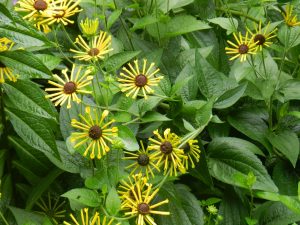
Rudbeckia subtomentosa ‘Henry Eilers’ closeup
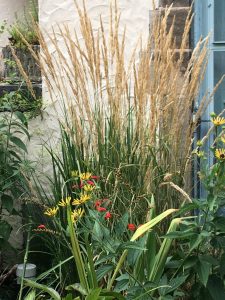
Rudbeckia subtomentosa ‘Henry Eilers’ with Crocosmia, and Panicum ‘Dewey Blue’
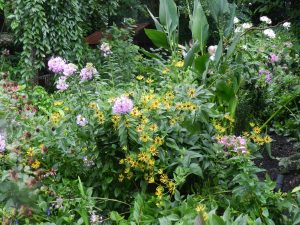
Rudbeckia subtomentosa ‘Henry Eilers’ with pink phlox in a pollinator garden.
Although Rudbeckia subtomentosa ‘Henry Eilers’ should be considered a stalwart, sadly, many gardeners are not acquainted with it and most perennial nurseries don’t grow it. Why? Perhaps, because it grows five feet tall. Happily, there is now a shorter cultivar called ‘Little Henry’ that would be a great addition to any sunny garden. Only three feet high, this Rudbeckia bears slightly golden yellow, lovely, quilled petals that surround a brown center that resembles a flattened acorn. It starts blooming in July and continues blooming into September. I’ve grown its parent for twelve years and been extremely happy with it. It does not seed like other Rudbeckia species nor does it run. It blends well with pink phloxes and orange perennials like Crocosmia and Echinacea as well as ornamental grasses. This pollinator plant should be more widely grown.
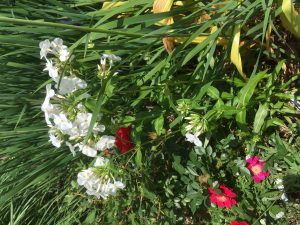
Phlox ‘Fashionably Early Crystal’ at base of Miscanthus ‘Adagio’(sorry but you will have to tilt your head sideways; the word processing program won’t let me rotate the image)

Phlox ‘Fashionably Early Crystal’ closeup
The problem with most Phlox paniculata is powdery mildew. Although some phloxes are touted as mildew-resistant, my experience has been that even the most resistant get some mildew. I’ll keep my fingers crossed but I am happy to report that in 2018, I planted Phlox ‘Fashionably Early Crystal’, a hybrid, and have been thrilled. First, absolutely no mildew (the leaves are thicker than those of straight paniculata cultivars – perhaps this is the explanation?). Second, and a great surprise, the length of bloom was astonishing: from early June until November. Supposedly, this phlox will grow 28-32” high and 26-30” wide although mine, so far, have only been eighteen inches high and I am still waiting for them to spread. Patience I say to myself; they are young. As one might guess from the name, Phlox ‘Fashionably Early Crystal’ is white but it has two cousins, ‘Fashionably Early Flamingo’ (magenta) and ‘Fashionably Early Lavender Ice’ (pale purple). This perennial, of course, should be grown in full sun but I will admit that mine is shaded in the morning.
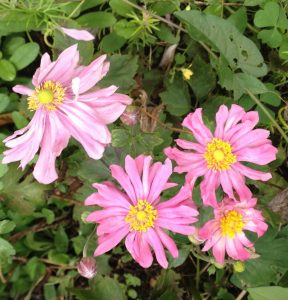
Anemone ‘Pretty Lady Emily’ in partial shade
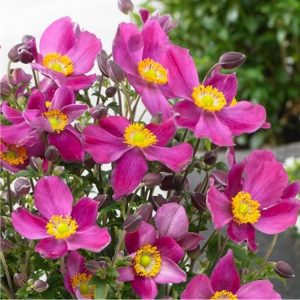
Anemone ‘Red Riding Hood’ close up – gardeningexpress.com

Anemone ‘Red Riding Hood’ in garden
I love Anemone hybrida for its fall bloom but admit that I would be happier without its rambunctious nature. I’ve also wished that there were shorter cultivars, the stalwarts always growing three feet high. Now, there are several new cultivars that are clumpers and shorter. One group is the Pretty Lady Series that includes both white and pink. These only grow twelve to fifteen inches high, blooming in September and October. I’ve been growing ‘Pretty Lady Emily’ since 2012 in partial shade. In 2018, she started blooming in mid-August. Another is the Swan Series. All the cultivars in this series are white although some have blue or purple backs. These range in height from fifteen to twenty-four inches high and some of them start blooming in July. A third group is the Fantasy Series. All these are varying shades of pink and are short, only twelve inches. A more recent addition in my garden (2017), ‘Red Riding Hood’ is a very deep rose pink. I only have three but need to get more so that they have more of an impact.
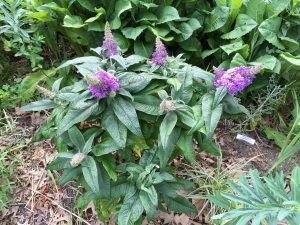
Buddleia ‘Pugster Amethyst’ in my garden
Buddleia will never be classified as a perennial but I can’t live without it in my garden. Most of the older cultivars are quite large. My ‘African Queen’ grows to eight feet every year in spite of cutting it way back each spring. There are now a number of dwarf cultivars but I have been quite impressed with ‘Pugster Amethyst’. The leaves are quite thick and I was amazed during the winter of 2019/2020 that they remained evergreen. The lavender blooms are very fat and dense and last a long time. This year, it was still blooming in November. It is planted in a sunny, fairly dry area of the garden so I am waiting for it to attain its purported height and spread of two feet. Right now it’s only half of that.
I’ve been able to purchase the phloxes and the Buddleia locally but have had to rely on mail order for the others.


0 Comments